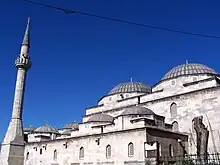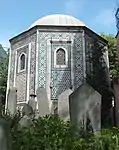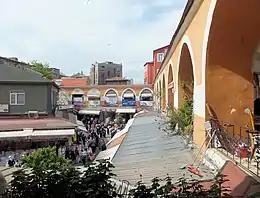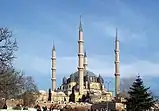Mahmut Pasha Mosque, Eminönü
The Mahmut Pasha Mosque (Turkish: Mahmut Paşa Camii) is a 15th-century Ottoman mosque near the Grand Bazaar in the Fatih district of Istanbul, Turkey.
| Mahmut Pasha Mosque | |
|---|---|
Mahmut Paşa Camii | |
 | |
| Religion | |
| Affiliation | Sunni Islam |
| Location | |
| Location | Eminönü, Istanbul, Turkey |
 Location within the Fatih district of Istanbul | |
| Geographic coordinates | 41.011354°N 28.971235°E |
| Architecture | |
| Type | mosque |
| Completed | 1464 |
| Specifications | |
| Dome(s) | 2 |
| Dome dia. (outer) | 12.5 m (41 ft) |
| Minaret(s) | 1 |
| Materials | ashlar |
History
The mosque was commissioned by the Greek Mahmud Pasha, the grand vizier of Sultan Mehmet II, who converted to Islam.[1] Completed in 1464, it was one of the first buildings within the city walls built specifically as a mosque.[2] Up to that time, most of the early mosques in the city were converted Byzantine churches.
The waqf (endowment) of the mosque and its associated charitable buildings was quite extensive, covering a number of different buildings across the surrounding district. This suggests that Mehmet II may have entrusted Mahmud Pasha with developing this district near the commercial heart of the city, just east and north of the area which would become the Grand Bazaar. The mosque was thus the centrepiece of this development.[3]
The mosque was completely restored and reopened in 2021. Restoration of the tomb was ongoing in 2022.
Architecture
The mosque is designed in the Bursa style with the main space covered by a number of identical domes. This is an early Ottoman style which was soon abandoned in favour of a single large dome with smaller extensions. In this case, the main space is a 2x1 rectangle covered with two identical domes, each with a diameter of 12.5 metres (41 ft).[4] The mihrab and minbar are located on the short side of the rectangle. The areas on either side are each covered by a simple sloping roof.
The entrance to the mosque is similar to that of a Byzantine church, with an outer porch (exonarthex) and an inner porch (esonarthex), each covered by five small domes. The columns holding up the outer porch were originally marble but were replaced by the present stone ones in the 18th century after damage by an earthquake. The mahfil was added in the 19th century, and the mihrab and minbar replaced; as a result, they are in a different style to the rest of the mosque.
The octagonal mausoleum (türbe) of Mahmud Paşa in the grounds of the mosque is dated AH 878 (1473-74 CE) on an inscription at the entrance.[4] Its exterior is decorated with tiles forming geometric patterns in turquoise and indigo colours, a feature which is unique in Ottoman architecture in Istanbul.[3]: 191
 View of the minaret of the mosque
View of the minaret of the mosque Courtyard of the mosque
Courtyard of the mosque Muqarnas and calligraphy over the mosque's entrance portal
Muqarnas and calligraphy over the mosque's entrance portal Mahmut Pasha Mosque interior
Mahmut Pasha Mosque interior The türbe (mausoleum) of Mahmud Pasha, behind the mosque
The türbe (mausoleum) of Mahmud Pasha, behind the mosque
Other buildings of the complex


Like many other Ottoman mosques, the Mahmut Pasha Mosque was part of a larger charitable complex, a külliye, composed of multiple buildings which were governed together through a waqf foundation (Turkish: vakıf). The külliye of Mahmut Pasha included, in addition to the mosque and the mausoleum, a hammam (public bathhouse), a han or caravanserai, a madrasa, an imaret (soup kitchen), a mahkeme (courtroom), and a mekteb (elementary school).[4] The waqf also specified the management of 27 houses, about 100 shops, and various other lodgings, storehouses, and stables, making this waqf foundation particularly wealthy for its kind.[3] Of these, only the hammam and the caravanserai, and one section of the madrasa, have survived to the present day. The various buildings were scattered in different locations across the surrounding district. The revenues generated by the hammam and the caravanserai contributed to the upkeep and operations of the mosque.[3][4][5]
The hammam of the complex, located northwest of the mosque, was completed in 1466 CE, making it one of the oldest hammams in the city. Its architecture and layout is highly similar to the Tahtakale Hamam built by Mehmet II slightly earlier. It was originally a double hammam, meaning it had separate (but adjacent) facilities for men and for women, but the women's section was demolished at some later date. The hammam was also damaged by fire in 1755 and was restored in 1953. It served as a storage depot for a time but now serves as a shopping centre.[3][6][5]
The caravanserai of the Mahmut Pasha complex, located north of the hammam, is known today as the Kürkçü Han ("Caravanserai of the Fur Merchants"). It was completed in 1467 and is the oldest surviving caravanserai in Istanbul, albeit with some modifications and restorations over time. The building contributed to the revenues of the mosque's waqf foundation by collecting rent from the shops and offices which occupied its many rooms (which at one point numbered 167). The caravanserai is still used by shops and businesses today.[7][5][8]
See also
References
- Freely, John (1998). Istanbul : the imperial city. Internet Archive. London ; New York : Penguin Books. p. 185. ISBN 978-0-14-024461-8.
- Goodwin 2003, pp. 109–113.
- Kuban, Doğan (2010). Ottoman Architecture. Antique Collectors' Club. pp. 189–191.
- Goodwin 2003, p. 110.
- Sumner-Boyd, Hilary; Freely, John (2010). Strolling Through Istanbul: The Classic Guide to the City (Revised ed.). Tauris Parke Paperbacks.
- Goodwin 2003, p. 113-114.
- Goodwin 2003, p. 109-110.
- Yaşar, Ahmet (2018). "The Construction Of Commercial Space In Eighteenth-Century Istanbul: The Case Of Büyük Yeni Han". Middle East Technical University Journal of the Faculty of Architecture. 35 (1): 183–200.
Further reading
- Goodwin, Godfrey (2003) [1971]. A History of Ottoman Architecture. London: Thames & Hudson. ISBN 978-0-500-27429-3.



.svg.png.webp)